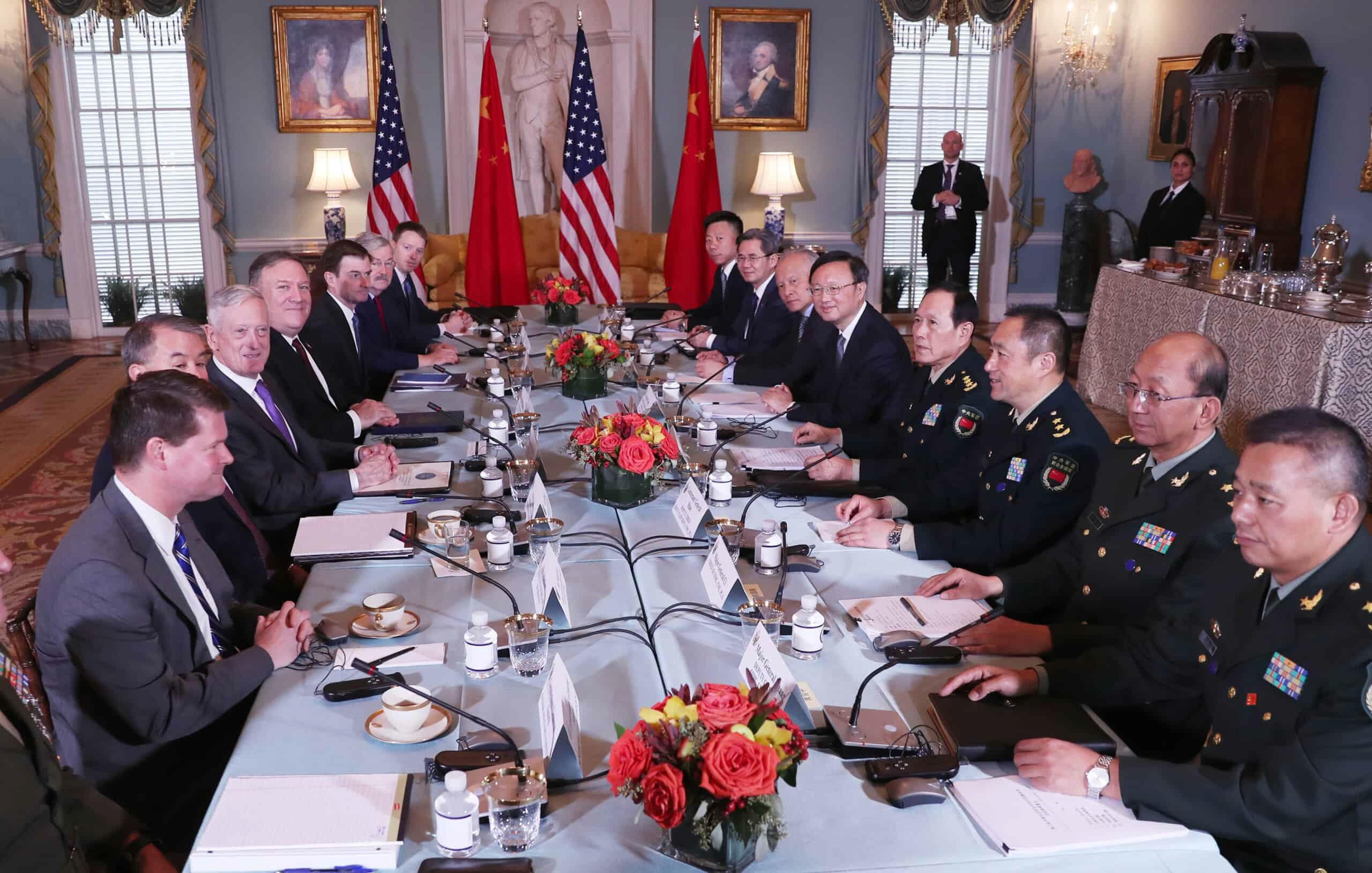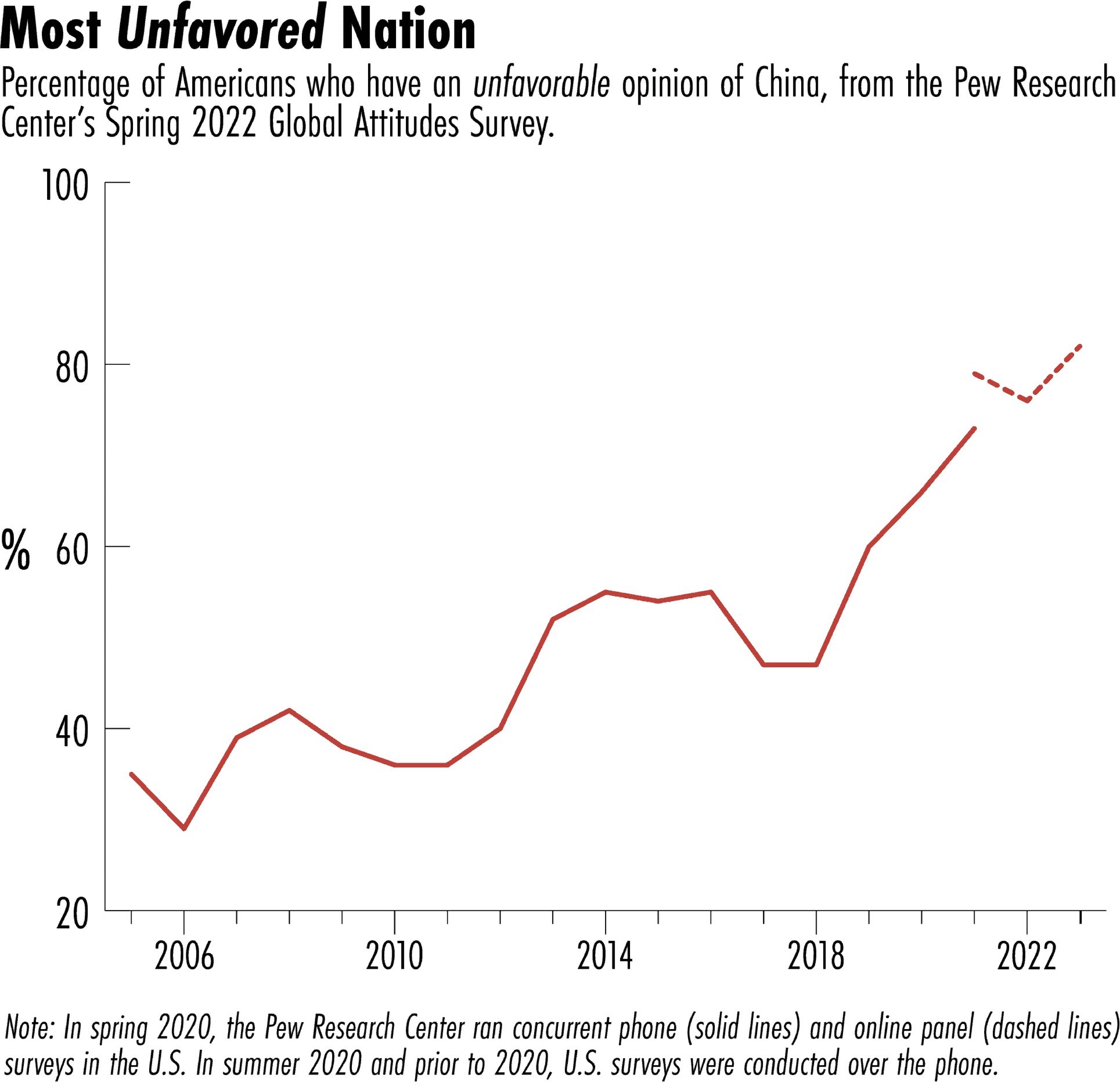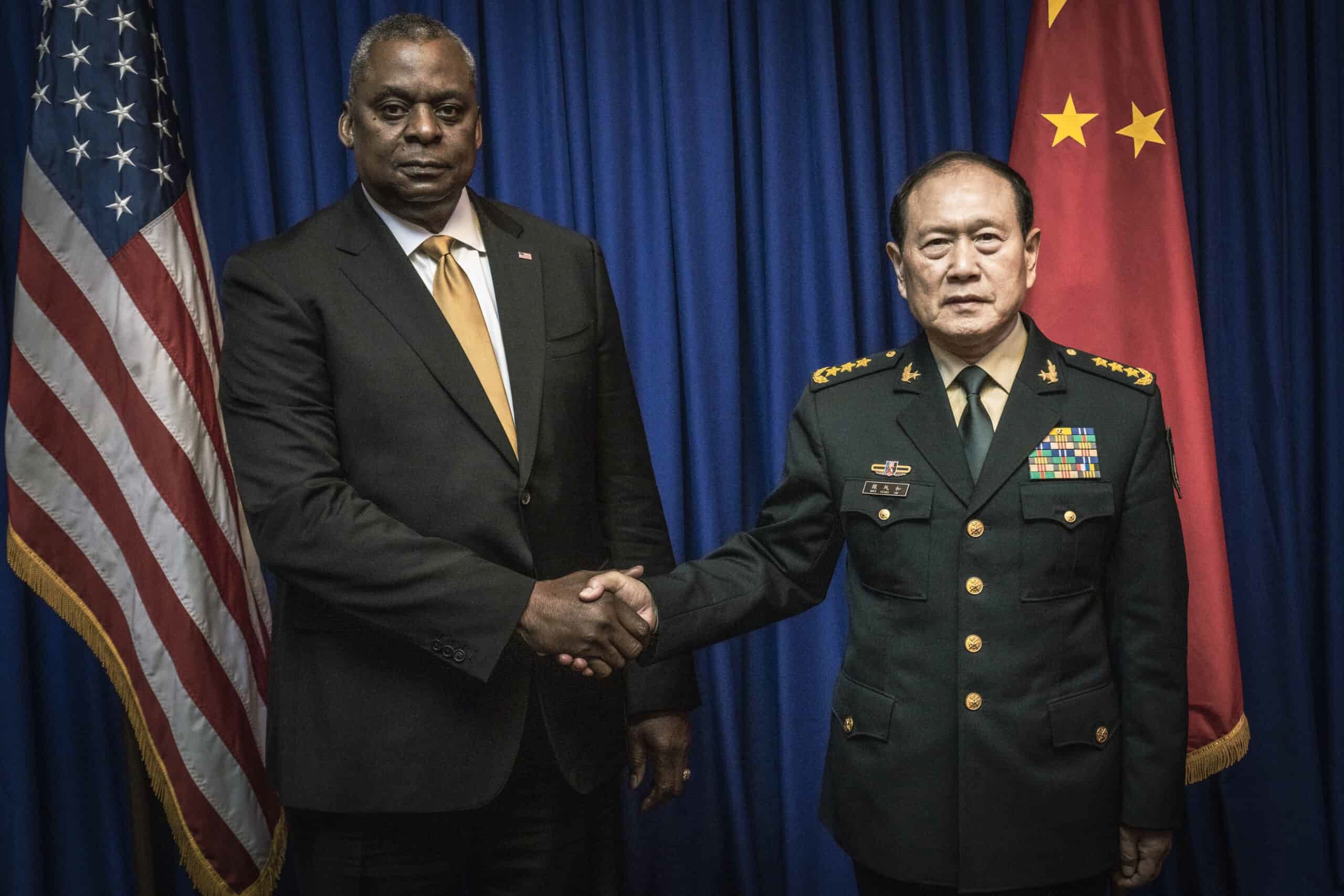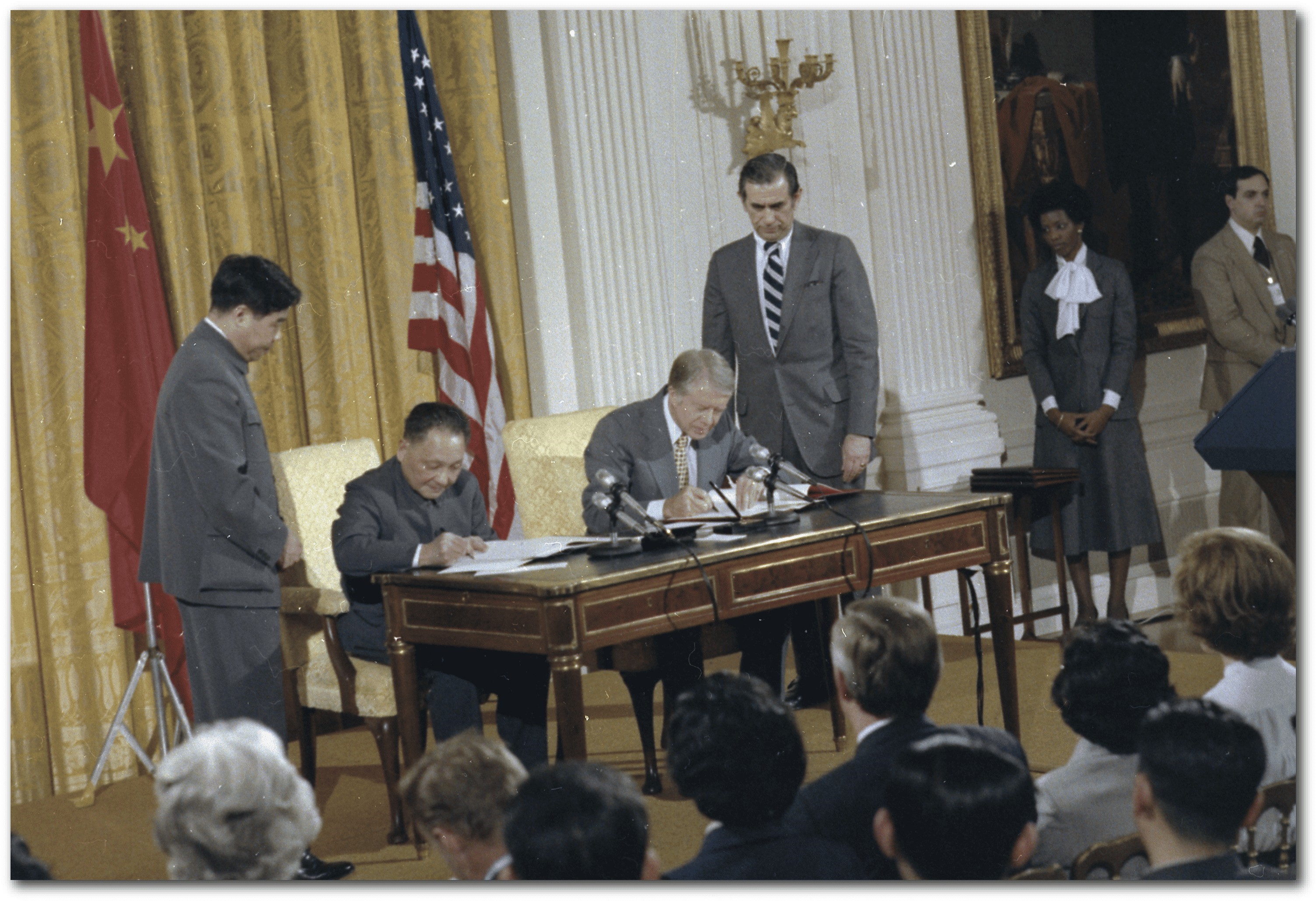
U.S. and Chinese officials meeting during the second U.S.-China Diplomatic and Security Dialogue, at the State Department in Washington, November 9, 2018. Credit: Ministry of National Defense (http://www.mod.gov.cn)
The telephone rang and rang in Beijing on February 4, 2023. U.S. Defense Secretary Lloyd Austin was attempting to call China’s defense minister, Wei Fenghe, to explain why two American F-22 fighter jets had been dispatched to shoot down an errant Chinese surveillance balloon off the coast of South Carolina. Minister Wei (who has subsequently been replaced by Li Shangfu) never took the call. His spokesperson claimed that a hyper-reactive U.S. had not created “the proper atmosphere” for an exchange of views. The day before, U.S. Secretary of State Antony Blinken had canceled an eagerly awaited trip to Beijing. A long-troubled relationship had quickly gone from bad to worse.
In retrospect, this was hardly surprising. In the past five years, the two superpowers have descended into a trade war, a tech war, and now a new cold war. Starting with the balloon fiasco, the downward spiral has intensified, involving acrimonious exchanges between leading diplomats on both sides, increasingly venomous bluster of China bashing from the U.S. Congress, and mounting tensions over Taiwan. China has also escalated, with Xi Jinping pointing the finger directly at U.S. containment, overseeing aggressive military exercises in the Taiwan Strait, and deepening his commitment to a new unlimited partnership with the Russian war machine.

There can be no mistaking America’s strident anti-China mindset. There is no constituency in the U.S. Congress that is in favor of rebuilding a relationship with China. The U.S. business community is afraid to speak out. Public polling shows U.S. sentiment toward China at record lows, irrespective of political party, demographic cohort, or educational background. Like the former Soviet Union, China has become ‘the enemy’. The mindset in China is similar — resignation over deepening conflict with America has now sunk in.
Thought leaders of the so-called Washington consensus have made matters worse. They have embraced a revisionist view of China — that engagement was the original sin of the U.S.-China relationship because it gave China free rein to take advantage of America’s deal-focused naiveté. China’s accession to the World Trade Organization in 2001 gets top billing in that respect: the U.S. offered access to its vast consumer markets, but China purportedly broke its promise to become more like America. Engagement, according to this convoluted but widely accepted argument, opened the door to security risks and human-rights abuses. Washington is now determined to slam that door shut.
As the ideological battle risks turning into a new arms race, the possibility of accidental conflict is high and rising. Kinetic wars can, and have, occurred when sparks ignite the high-octane fuel of conflict escalation. Think June 1914, when a simmering conflict between the great powers of Europe quickly turned into The Great War in the immediate aftermath of a political assassination. Are we at risk of sleepwalking into another catastrophic moment in history?
The unanswered phone call said it all: there is no viable framework of engagement that enables both governments to exchange views with one another, to sort out their differences. Surrender, or appeasement, is hardly an option for either nation. Co-existence is the only way out. How to achieve that is another matter altogether. Both countries must rethink the way they exchange views and resolve their differences. The United States and China need a new architecture of engagement, one that is divorced from the blame- game of conflict and grounded in an objective and comprehensive assessment of relationship opportunities.
A joint U.S.-China Secretariat offers that structure. Traditionally, secretariats enhance the bureaucratic functionality of multilateral organizations, like the United Nations and the World Trade Organization. Secretariats provide important service functions — dialogues for intercommunication, a forum for negotiations, and a synthesis of nuanced views on shared issues. A U.S.-China secretariat would provide, at a minimum, sorely needed administrative cohesion between the United States and China. It would be the first such effort involving just two nations.
But this deeply troubled relationship needs far more than a new bureaucracy. A U.S.-China secretariat should, first and foremost, be a keeper of the collective consciousness of relationship management. This must be based on a shared determination of both nations to convert conflict escalation into conflict resolution — before it is too late.
The place to start is by taking a clear-eyed look at what has gone wrong. Previous high-level Strategic and Economic Dialogues accomplished little. Long on the choreography of grand summits, there was little momentum after these meetings. The process lacked continuity, and a foundation of focus and expertise. A U.S.-China secretariat would shift the attention on relationship issues from part-time to full-time, leaving no need to resurrect earlier failed dialogue structures.
The offices of the new secretariat should be in a neutral jurisdiction, like Switzerland or Singapore, and staffed by equal complements of American and Chinese professionals for whom the relationship would be a 24-7 responsibility. It would serve as a collaborative platform focused on all aspects of U.S.-China relations — from economics and trade, to innovation policy and technology transfer, to human rights, climate change, global health, and cybersecurity. The new secretariat, organized functionally rather than as two stand-alone, siloed, country-specific efforts, would have the following key responsibilities:
Relationship Framing
The development of an evidence- and research-based platform aligned with the broad remit of the secretariat would be a core function of the new organization. Aimed at providing leaders and other decision-makers in the two nations with a common set of shared, fact-based policy options, this function would feature jointly authored policy background, or “white papers,” that would be channeled directly into congressional deliberations of both nations. While other leading powers might understandably object to being left out of this bilateral organization, the whole point of a U.S.-China secretariat would be to repair a severely damaged relationship between two superpowers. If progress is made, collaborative possibilities with other nations, including potential secretariat expansion, could be considered.
The research effort would also include joint database development and management. This should entail quality scrubbing of dual-platform statistics maintained individually by the two countries, as well as protocols for data security. The aim is a shared framework of fact-based support for joint research, for regular meetings between senior officials of both nations, and for sorely needed military-to-military discussions. A public version of the secretariat’s database should be updated regularly and made available to registered users.

Secretary of Defense Lloyd J. Austin III meets with Chinese Defense Minister Wei Fenghe in Siem Reap, Cambodia, November 22, 2022. Credit: U.S. Department of Defense (https://www.defense.gov/News/News- Stories/Article/Article/3225557/competition-remains-defining-feature-of-us-china-relations-but- communications-s/)
Convening and Troubleshooting
The secretariat should serve as a hub for convening and integrating existing networks of relationship expertise in both nations, including academia, think tanks, business and trade associations, and groups engaged in Track II dialogues. The intent would not be for the secretariat to intervene in these activities but to offer a platform for expert talent to come together and examine critical issues of mutual interest.
The lack of collaborative efforts during the early stages of the Covid-19 pandemic is a good example of how the convening function of an effective secretariat might have made a real difference. Fixated on the blame game of the Covid origins debate — zoonotic transmission vs. the Wuhan lab accident — the U.S. and China turned a pandemic into geopolitical theater. Had experts — scientists, epidemiologists, and public health practitioners — from both the United States and China been invited by the secretariat to develop a consensus in understanding the outbreak, its potential ramifications, and the protocols needed for containment and mitigation, policy blunders might have been avoided that subsequently endangered the public health of both nations, and the world at large.
A related task is the need for the secretariat to provide a troubleshooting mechanism to handle urgent developments that may arise between superpowers. Never again should a phone call between two defense ministers go unanswered at a moment of near crisis. Not only would the secretariat have a secure “hotline” capacity aimed at backstopping normal government communications channels, but there would be a crisis response team that would quickly assemble U.S. and Chinese experts for joint troubleshooting and remedial decision options.
Oversight and Compliance
The secretariat would oversee the implementation and monitoring of existing and new agreements between the United States and China. As such, it would be empowered to operate within the pre-existing legal and institutional multilateral framework established by the UN and the WTO, while also maintaining conformity with the three joint diplomatic communiqués that set the rules of bilateral engagement between the U.S. and China in the 1970s and early 1980s. The development and use of “dashboards” to track implementation and compliance of joint agreements would be especially helpful with new compacts (hopefully, a Bilateral Investment Treaty) or with old ones (such as China’s WTO accession protocols).

Deng Xiaoping and Jimmy Carter at the signing ceremony for the Joint Communiqué on the Establishment of Diplomatic Relation January 1, 1979. Credit: USNARA
In today’s complex and challenging world, conflicts are bound to arise over contentious structural issues like intellectual property rights, technology transfer, state-supported industrial subsidies, and cybersecurity. A U.S.-China secretariat, empowered with a transparent dispute screening function, has the potential to play a leading role in conflict management. It could provide a first stop for the airing of grievances between the two nations that could be screened, evaluated, and conceivably resolved by the secretariat prior to formal submission of complaints to higher authorities at the WTO or World Bank.
Outreach
The secretariat should also have a robust outreach function, featuring a transparent web-based platform, the public version of the U.S.-China database, working papers of the secretariat staff, and a co-authored quarterly review of U.S.-China relationship issues. The secretariat should sponsor regular public conferences driven by the relationship agenda and press officers should hold frequent joint briefings.
Governance
The new secretariat should not be viewed as an autonomous policy authority but more as an apolitical bilateral think tank and consultative organization. Earlier joint efforts between the World Bank and China’s Development Research Center — the China 2030 project of 2013 and Urban China of 2014 — are noteworthy precedents that underscore China’s potential to engage in collaborative policy-driven research. The secretariat should be staffed by experts — technocrats, if you like — who possess the wide-ranging skill sets required of Sino-American relationship management. That would include, but not be limited to trade experts, economists, lawyers, diplomats, scientists, and technologists. Chinese and American co-heads of the secretariat, empowered as cabinet-level policy advisors to their respective governments, would be responsible for talent selection. While the co-heads would oversee their respective staffs, they would be urged to integrate them into commingled US-China departments rather than operate as siloed, country teams. Secretariat leadership should consult regularly with an actively engaged outside advisory board with equal representation drawn from the United States and China, as well as from other key countries.
The basic point of a secretariat would be to elevate the bilateral U.S.-China relationship to the importance it deserves in the governance of both nations. This will undoubtedly be the new organization’s greatest challenge. Each nation typically approaches the other from its own perspective, with its own insights, biases, objectives, and aspirations. In a climate of deepening distrust and escalating conflict, there is no sharing of efforts, no mutual problem-solving capacity, and no collaborative relationship management.
Distrust and blame are at the heart of the Sino-American relationship crisis. The breakdown in trust of the past several years also has come amid mounting existential threats — catastrophic climate change, the legacy effects of a virulent pandemic, and a tragic war in eastern Europe. A U.S.-China secretariat offers the possibility of lasting re-engagement, an off-ramp from the quagmire of conflict escalation, and a shared sense of accomplishment from tackling the world’s toughest problems. It would come with the added bonus of collaborative efforts housed in a shared workspace that would nurture a climate of interpersonal familiarity.
Trust building often starts with small steps. Both the United States and China need that more than ever. As superpower conflict nears a flash point, a new architecture of Sino-American engagement must become an urgent priority. A U.S.-China secretariat could go a long way in repairing the weakest link in a dangerously dysfunctional relationship.
